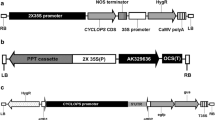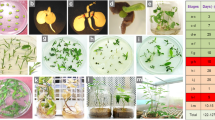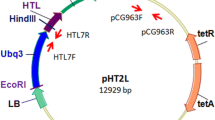Abstract
Genetic transformation has been achieved for several citrus genotypes. However, regeneration of escapes at high frequency is a major problem, making the available procedures rather inefficient. Attempts to improve selection by increasing the concentration of kanamycin, used as the selective agent, or substituting it by geneticin have been unsuccessful. Here, we have critically assessed the actual frequency and origin of escapes in citrus by using visual screening with β-glucuronidase (gusA) and green fluorescent protein (gfp) markers, by studying the persistence of engineered Agrobacterium in the explants, and by characterising through Southern blot analysis all the regenerants obtained under kanamycin selection. Our results show that inefficient selection could be attributed to the protection of the non-transformed cells from the selective agent by the surrounding transformed cells, and to the persistence of kanamycin-resistance Agrobacterium in explant tissues over long periods of time after co-cultivation. This also explained the high frequency (12%) of chimeric shoots that were commonly recovered. High frequency regeneration of chimeras that resulted from the fusion of different transformation events is reported for the first time. On the other hand, molecular analysis of all the regenerants reveals that transformation frequency is underestimated when based on the expression of a screenable marker gene, and that low expressors and silenced lines could account for at least 25% of those plants considered escapes based on selectable and screenable marker analysis. Consequences of these results at the practical level are also discussed.
Similar content being viewed by others
References
Berthomieu P., Beclin C., Charlot F., Dore C. and Jouanin L. 1994. Routine transformation of rapid cycling cabbage (Brassica oleracea)-molecular evidence for the regeneration of chimeras. Plant Sci. 96: 223–235.
Birch R.G. 1997. Plant transformation: problems and strategies for practical application. Ann. Rev. Plant Physiol. Plant Mol. Biol. 48: 297–326.
Bond J.E. and Roose M.L. 1998. Agrobacterium-mediated transformation of the commercially important citrus cultivar Washington navel orange. Plant Cell Rep. 18: 229–234.
Cervera M., Juárez J., Pina J.A., Navarro L. and Peña L. 1998a. Agrobacterium-mediated transformation and regeneration of citrange: factors affecting transformation and regeneration. Plant Cell Rep. 16: 271–278.
Cervera M., Navarro A., Juárez J., Pina J.A., Navarro L. and Peña L. 1998b. Genetic transformation and regeneration of mature tissues of woody fruit plants bypassing the juvenile stage. Transgenic Res. 7: 51–59.
Christou P. 1990. Morphological description of transgenic soybean chimeras created by delivery, integration and expression of foreign DNA using electric discharge particle acceleration. Ann. Botany 66: 379–386.
Christou P. and McCabe D.E. 1992. Prediction of germ-line transformation events in chimeric Ro transgenic soybean plantlets using tissue-specific expression patterns. Plant J. 2: 283–290.
Christou P and Ford T.L. 1995. Recovery of chimeric rice plants from dry seed using electric discharge particle acceleration. Ann. Botany 75: 449–454.
Macf._ and production of 181 transgenic plants containing carotenoid biosynthetic genes}. Plant Cell Rep. 21: 365–373.
Cubero J., Martínez M.C., Llop P. and López M.M. 1999. A simple and efficient PCR method for the detection of Agrobacterium tumefaciensin plant tumours. J. Appl. Microbiol. 86: 591–602.
De Vetten N., Wolters A.M., Raemakers K., Van der Meer I., Ter Stege R., Heeres E., Heeres P. and Visser R. 2003. A transformation method for obtaining marker-free plants of a cross-pollinated and vegetatively propagated crop. Nature Biotech. 21: 439–442.
Dellaporta S.L., Wood J. and Hicks J.B. 1983. A plant DNA minipreparation: version II. Plant Mol. Biol. Rep. 4: 19–21.
Domínguez A., Guerri J., Cambra M., Navarro L., Moreno P. and Peña L. 2000. Efficient production of citrus transgenic plants expressing the coat protein gene of Citrus Tristeza Virus. Plant Cell Rep. 19: 427–433.
Domínguez A., Hermoso de Mendoza A., Guerri J., Cambra M., Navarro L., Moreno P. and Peña L. 2002a. Pathogen-derived resistance to citrus tristeza virus (CTV) in transgenic Mexican lime (Citrus aurantifolia (Christm.) Swing.) plants expressing its p25 coat protein gene. Mol. Breed. 10: 1–10.
Domínguez A., Fagoaga C., Navarro L., Moreno P. and Peña L. 2002b. Regeneration of transgenic citrus plants under non selective conditions results in high frequency recovery of plants with silenced transgenes. Mol. Genet. Genom. 267: 544–556.
Dong J.Z. and McHughen A. 1993. An improved procedure for production of transgenic flax plants using Agrobacterium tumefaciens. Plant Sci. 88: 61–71.
Ghorbel R., Juárez J., Navarro L. and Peña L. 1999. Green fluorescent protein as a screenable marker to increase the efficiency of generating transgenic woody fruit plants. Theor. Appl. Genet. 99: 350–358.
Ghorbel R, Domínguez A., Navarro L. and Peña L., 2000. High efficiency genetic transformation of sour orange (Citrus aurantium L.)and production of transgenic trees containing the coat protein gene of Citrus Tristeza Virus. Tree Physiol. 20: 1183-1189.
Ghorbel R., LaMalfa S., López M.M., Petit A., Navarro L. and Peña L. 2001a. Additional copies of virGfrom pTiBo542 provide a super-transformation ability to Agrobacterium tumefaciensin citrus. Physiol. Mol. Plant Pathol. 58: 103–110.
Ghorbel R., López C., Moreno P., Navarro L., Flores R. and Peña L. 2001b. Transgenic citrus plants expressing the Citrus Tristeza Virusp23 protein exhibit viral-like symptoms. Mol. Plant Pathol. 2: 27–36.
Gutiérrez M.A., Luth D.E. and Moore G.A. 1997. Factors affecting Agrobacterium-madiated transformation in Citrus and production of sour orange Citrus aurantiumL._ plants expressing the coat protein gene of Citrus Tristeza Virus}. Plant Cell Rep. 16: 745–753.
Harjeet K., Raina S.K., Srinivasulu and Kumar K. 1997.Biolistic transformation of elite indica rice (Oryza sativa L.) cultivars through semi-solid and liquid medium selection systems. J. Plant Biochem. Biotech. 6: 75-80.
Jefferson R.A., Kavanagh T.A. and Bevan M.W. 1987. GUS fusions β-glucuronidase as a sensitive and versatile gene fusion marker in higher plants. EMBO J. 6: 3901-3907.
Joersbo M., Brunstedt J., Marcussen J. and Okkels F. 1999. Transformation of the endospermous legume guar (Cyamopsis tetragolonoba L.) and analysis of transgene transmission. Mol. Breed. 5: 521-529.
Jordan M.C. and McHughen A. 1988. Transformed callus does not necessarily regenerate transformed shoots. Plant Cell Rep. 7: 285–287.
Kim J.W. and Minamikawa T. 1996. Transformation and regeneration of french bean plants by the particle bombardment process. Plant Sci. 117: 131–138.
Kuvshinov V., Koivu K., Kanerva A. and Pehu E. 1999. Agrobacterium tumefaciens-mediated transformation of greenhousegrown Brassica rapa ssp. oleifera. Plant Cell Rep. 18: 773–777.
Landgridge P., Brettschneider R., Lazzeri P. and Lörz H. 1992. Transformation of cereals via Agrobacteriumand the pollen pathway: a critical assessment. Plant J. 2: 631–638.
Luth D. and Moore G. 2000. Transgenic grapefruit plants obtained by Agrobacterium tumefaciens-mediated transformation. Plant Cell Tiss. Org. Cult. 57: 219–222.
Manaham S.H. and Steck T.R. 1997. The viable but nonculturable state in Agrobacterium tumefaciensand Rhizobium meliloti. FEMS Microbiol. Ecol. 22: 29–37.
Matzk A., Mantell S. and Schiemann J. 1996. Localization of persisting Agrobacteria in transgenic tobacco plants. Mol. Plant-Microbe Interact. 9: 373–381.
May G.D., Afza R., Mason H.S., Wiecko A., Novak F.J. and Arntzen C.J. 1995. Generation of transgenic banana (Musa Acuminata) plants via Agrobacterium-mediated transformation. Biol Technology 13: 486-492.
McHughen A. and Jordan M.C. 1989. Recovery of transgenic plants from 'escape' shoots. Plant Cell Rep. 7: 611–614.
Mourgues F., Chevreau E., Lambert C. and Bondt A. 1996. Efficient Agrobacterium-mediated transformation and recovery of transgenic plants from pear (Pyrus communisL.). Plant Cell Rep. 16: 245–249.
Murashige T. and Skoog F. 1962. A revised medium for rapid growth and bioassay with tobacco tissue cultures. Physiol. Plant. 15: 473–479.
Niu X., Li X., Veronese P., Bressan R.A., Weller S.C. and Hasegawa P.M. 2000. Factors affecting Agrobacterium tumefaciensmediated transformation of peppermint. Plant Cell Rep. 19: 304–310.
Park S.H., Rose S.C., Zapata C., Srivatanakul M. and Smith R.H. 1998. Cross-protection and selectable marker genes in plant transformation. In Vitro Cell. Dev. Biol.-Plant 34: 117–121.
Peña L., Cervera M., Juárez J., Ortega C., Pina J.A., Durán-Vila N. and Navarro L. 1995a. High efficiency Agrobacterium-mediated transformation and regeneration of citrus. Plant Sci. 104: 183–191.
Peña L., Cervera M., Juárez J., Navarro A., Pina J.A., Durán-Vila N. and Navarro L. 1995b. Agrobacterium-mediated transformation of sweet orange and regeneration of transgenic plants. Plant Cell Rep. 14: 616–619.
Peña L., Cervera M., Juárez J., Ortega C., Pina J.A., Durán-Vila N. and Navarro L. 1997. Genetic transformation of lime (Citrus aurantifolia Swing): factors affecting transformation and regeneration. Plant Cell Rep. 16: 731-737.
Peña L. and Navarro L. 1999. Transgenic citrus. In: Bajaj Y.P.S. (ed.), Biotechnology in Agriculture and Forestry: Transgenic Trees. Springer-Verlag, Berlin, Heidelberg, Germany, pp. 39–53.
Peña L., Martín-Trillo M., Juárez J., Pina J.A., Navarro L. and Martínez-Zapater J.M. 2001. Constitutive expression of Arabidopsis LEAFY and APETALA1 genes in citrus reduces their generation time. Nature Biotech. 19: 263–267. 182
Vitis viniferaL._: The role of antioxidants during grape-Agrobacteriuminteractions}. Nature Biotech. 14: 624–628.
Poethig S. 1989. Genetic mosaics and cell lineage analysis in plants. Trends Genet. 5: 273–277.
Schmülling T. and Schell J. 1993. Transgenic tobacco plants regenerated from leaf disks can be periclinal chimeras. Plant Mol. Biol. 21: 705–708.
Schroth M.N., Thompson J.P. and Hildebrand D.C. 1965. Isolation of Agrobacterium tumefaciens-A. radiobactergroup from the soil. Phytopathol. 55: 645–647.
Seabra R.C. and Pais M.S. 1998. Genetic transformation of European chestnut. Plant Cell Rep. 17: 177–182.
Ulian E.C., Magill J.M., Magill C.W. and Smith R.H. 1996. DNA methylation and expression of NPTII in transgenic petunias and progeny. Theor. Appl. Genet. 92: 976–981.
Vancanneyt G., Schmidt R., O'Connor-Sánchez A., Willmitzer L. and Rocha-Sosa M. 1990. Construction of an intron-containing marker gene: splicing of the intron in transgenic plants and its use in monitoring early events in Agrobacterium-mediated plant transformation. Mol. Gen. Genet. 220: 245–250.
Citrus paradidiMacf._}. Plant Cell Rep. 19: 1203–1211.
Yu C., Huang S., Chen C., Deng Z., Ling P. and Gmitter F.G. 2002. Factors affecting Agrobacterium-mediated transformation of sweet orange and citrange. Plant Cell Tiss. Org. Cult. 71: 147–155.
Beta vulgarisL._}. Mol. Biotechnol. 17: 109–117. 183
Author information
Authors and Affiliations
Rights and permissions
About this article
Cite this article
Domínguez, A., Cervera, M., Pérez, R.M. et al. Characterisation of regenerants obtained under selective conditions after Agrobacterium-mediated transformation of citrus explants reveals production of silenced and chimeric plants at unexpected high frequencies. Molecular Breeding 14, 171–183 (2004). https://doi.org/10.1023/B:MOLB.0000038005.73265.61
Issue Date:
DOI: https://doi.org/10.1023/B:MOLB.0000038005.73265.61




